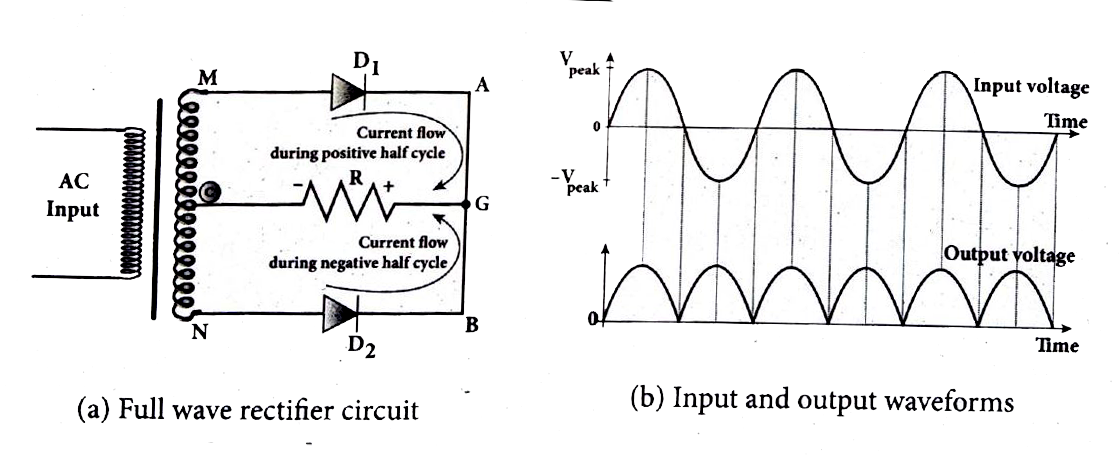Explain the construction and working of a full wave rectifier.Solution in Tamil
The positive and negative half cycles of the AC input signal pass through the full wave rectifier Circuit an hence it is called the full wave rectifier . It consists of two p-n junction diodes ,a center tapped transformer , and a load resistor (RL) .The centre is usually taken as the gound or zero voltage reference point . due to the centre tap transformer , the output voltage rectified by each diode is only one half of the total secondary voltage.

During positive half cycle
When the positive half cycle of the ac input signal passes through the circuit , terminal M is positive, G is at zero potential and N is at negative potential . This forward biases diode D1 and reverse biases diode D2 . Hence being forward biases, diode D1 conducts and current flows along the path MD1 AGC . As a result positive half cycle of the voltage appears RL in the direction G to C.
During negative half cycle.
when the negative half cycle of the ac input signal passes through the circuit, terminal N is positive ,G is at zero potential and M is at negative potential . This forward biases diode D2 and reverse biases diode D1 . Hence, being forward biased, diode D2 conducts and current flows along the path ND2 BGC . As a result negative half cycle of the voltage appears across RL the same direction from G to C
Hence in a full wave rectifier both positive and negative half cycles of the input signal pass through the circuit in the same direction as shown in figure (b). Though both positive and negative half cycles of ac input are rectifier is twice that of a half wave rectifier and is found be 81.2 % it is because both the positive and negative half cycles of the ac input source are rectified.
Topper's Solved these Questions
- BOOK - FULL MARKSCHAPTER - SAMPLE PAPER -4 (SOLVED)EXERCISE - PART-III9videos
SAMPLE PAPER -4 (SOLVED)
- BOOK - FULL MARKSCHAPTER - SAMPLE PAPER -14 (UNSOLVED)EXERCISE - PART-IV9videos
SAMPLE PAPER -14 (UNSOLVED)
- BOOK - FULL MARKSCHAPTER - SAMPLE PAPER 3 (SOLVED)EXERCISE - PART- IV10videos
SAMPLE PAPER 3 (SOLVED)
Similar Questions
A sample of HCI gas is placed in a uniform electric field of magnitude 3×104N.C−1 . The dipole moment of each HCI molecule is 3.4×10−39 Cm. Calculate the maximum torque experienced each HCI molecule.
View SolutionExplain the equivalent resistance of a series and parallel resistor network.
10:04View SolutionExplain in detail the construction and working of a Van de Graaff generator.
08:01View SolutionWhat is rectification ? Explain the working of a full wave rectifier.
05:19View SolutionExplain the working of full wave rectifier with diagram ?
08:01View SolutionExplain the construction and working of a full wave rectifier.
08:01View SolutionWhat is full wave rectification? Explain the working of a full wave rectifier. Indicate the wave forms of input and output voltage.
08:01View SolutionExplain the construction and working of a full wave rectifier.
08:01View SolutionExplain the construction and working of a full wave rectifier.
08:46View SolutionExplain the construction and working of a full wave rectifier.
05:18View SolutionExplain the construction and working of a full wave rectifier.
04:07View SolutionWhat is rectifier explain the working of junction diode as a full wave rectifier diagram
04:23View SolutionWhat is rectifier ? Explain the working of junction diode as a full wave rectifier, with diagram.
02:48View SolutionDiscuss the construction and working of diode as full wave rectifier
05:18View SolutionWith the help of a diagram explain the working of a full wave center tapped rectifier.
View Solution
